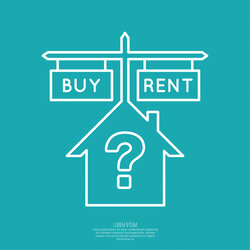The dream of owning a home is a universal aspiration, but for many, financial or credit challenges make it seem unattainable. Rent-to-own agreements offer a unique path to homeownership, bridging the gap between renting and buying. If you’re curious about how rent-to-own works in real estate, this guide will provide an in-depth look at the process, the benefits, the potential pitfalls, and whether this option might be right for you.

What Is Rent-to-Own?
Rent-to-own is a real estate arrangement where a tenant agrees to rent a property for a specified period with the option to purchase it at the end of the lease term. This hybrid agreement combines elements of renting and buying, making it particularly appealing to individuals who may not yet qualify for a traditional mortgage but are working towards homeownership.
How Does Rent-to-Own Work?
1. The Agreement
A rent-to-own contract typically includes two components:
- Lease Agreement: This outlines the terms of the rental period, including monthly rent, duration, and tenant responsibilities.
- Option to Purchase: This gives the tenant the exclusive right to buy the property at the end of the lease term for a predetermined price.
There are two main types of rent-to-own agreements:
- Lease Option Agreement: The tenant has the option but not the obligation to purchase the property.
- Lease-Purchase Agreement: The tenant is legally obligated to buy the property at the end of the lease term.
2. Option Fee
To enter into a rent-to-own agreement, tenants usually pay an upfront option fee, also known as a “consideration fee.” This fee, typically ranging from 1% to 5% of the property’s purchase price, secures the tenant’s right to purchase the home. The option fee is often non-refundable but is applied toward the purchase price if the tenant decides to buy the property.
3. Monthly Rent Payments
Tenants in rent-to-own agreements pay monthly rent, which may be slightly higher than market rates. A portion of these payments, known as “rent credits,” is typically set aside and applied toward the purchase price. For example, if your rent is $1,500 per month and $300 of that is credited toward the purchase price, you would accumulate $3,600 annually in rent credits.

4. Home Price Agreement
At the start of the lease, the future purchase price of the property is negotiated and locked in. This price remains fixed, regardless of market fluctuations. This can be advantageous if property values rise during the lease term, but it could be a downside if values decline.
5. Inspection and Maintenance
Rent-to-own contracts often place some maintenance and repair responsibilities on the tenant. Before entering an agreement, the home should be inspected to ensure it’s in good condition. Tenants should also clarify which repairs they’re responsible for and which the landlord will handle.
6. Financing at the End of the Lease
At the end of the lease term, the tenant must secure financing to purchase the property. This usually involves obtaining a mortgage. The option fee and any accumulated rent credits are applied toward the down payment or closing costs, helping to reduce the out-of-pocket expense.
Benefits of Rent-to-Own Agreements
Rent-to-own arrangements offer several advantages for both tenants and property owners:
1. For Tenants
- Path to Homeownership: Rent-to-own is ideal for individuals who are not yet financially ready to buy but are working toward that goal.
- Locked-In Purchase Price: Knowing the future price of the home provides stability and predictability.
- Credit Building Opportunity: Regular, on-time rent payments can help tenants build their credit scores.
- Rent Credits: A portion of monthly payments goes toward the purchase price, effectively acting as a forced savings plan.
2. For Property Owners
- Income Stability: Owners receive consistent rental income throughout the lease term.
- Potential Sale: Rent-to-own agreements increase the likelihood of selling the property without the need for extensive marketing or negotiations.
- Reduced Tenant Turnover: Tenants with a vested interest in the property are more likely to treat it as their own and stay for the long term.
Drawbacks of Rent-to-Own Agreements

Despite their benefits, rent-to-own agreements come with risks and potential downsides:
1. For Tenants
- Loss of Option Fee: If you choose not to buy the property or fail to secure financing, the option fee and rent credits are typically forfeited.
- Higher Monthly Costs: Rent-to-own arrangements often have higher monthly rent payments than standard leases.
- Risk of Market Fluctuations: If the market value of the home declines, you may end up overpaying for the property.
2. For Property Owners
- Uncertainty of Sale: If the tenant decides not to purchase the property, the owner may need to find another buyer.
- Tenant Risk: If tenants fail to maintain the property or default on their lease, the owner may face additional costs and delays.
Who Is Rent-to-Own Best For?
Rent-to-own agreements are particularly beneficial for:
- Credit-Challenged Buyers: Those with low credit scores who need time to improve their financial standing.
- First-Time Homebuyers: Individuals who want to experience living in the home and neighborhood before committing to a purchase.
- Self-Employed Individuals: People with irregular income who need more time to qualify for a mortgage.
However, they may not be ideal for those who are unsure about their long-term plans or who anticipate significant life changes during the lease term.
Tips for a Successful Rent-to-Own Experience

To make the most of a rent-to-own agreement, follow these tips:
1. Do Your Homework
Research the property, neighborhood, and local market conditions to ensure the purchase price is reasonable.
2. Get a Home Inspection
Hire a professional inspector to assess the property’s condition and identify any potential issues before signing the agreement.
3. Understand the Contract
Work with a real estate attorney to review the terms of the agreement and clarify any ambiguities.
4. Improve Your Finances
Use the lease period to save money, pay down debt, and improve your credit score to qualify for a mortgage.
5. Communicate with the Owner
Maintain open lines of communication with the property owner to address any concerns or issues that arise during the lease.
Conclusion
Rent-to-own agreements can be a powerful tool for achieving homeownership, especially for individuals facing financial or credit challenges. By understanding the process, weighing the pros and cons, and carefully planning your approach, you can turn the dream of owning a home into a reality.
If you’re considering a rent-to-own arrangement, take the time to evaluate your options, consult with professionals, and ensure you’re fully informed. With the right strategy, this innovative real estate solution could be your pathway to a brighter future.